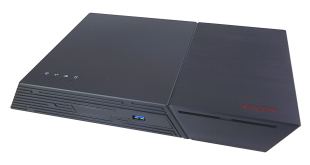Asustor are using an operating system which is in the early stages of development, we wouldn't expect the same level of polish and refinement as we get from the Synology DiskStation Manager.
Over the last week of use, we can report that the operating system is actually very robust and stable.
Asustor call the operating system ‘Asustor Data Master' which is unfortunate as it sounds more like a simple hard drive repair utility than a fully fledged Linux operating system.
While the name of the Operating System is less than ideal, in operation it will appeal to the inexperienced NAS user.

We decided to try an Apple Macintosh today, using the latest OSX operating system (10.8.3). We installed the software suite from the optical disc, which took only a few seconds.Over Wireless the NAS system was found within the space of a few seconds. We had an alert ‘the following server have not been configured yet'. So we selected the 602T.

The second stage of installation can either be a ‘one step setup' or a custom setup. We opted for the one click as we feel most people will be using this.

The next stage is to configure the network name for the NAS system, along with a password. Asustor are trying to make this as simple as possible and instead of asking about RAID configurations, they simply ask if you want the maximum capacity of the drives in the unit, or a ‘balanced' setting. We went for maximum capacity.

The software has now gathered enough information to start setting up the NAS into a basic configuration to use. This takes a few minutes – we used 500GB HDD's so it might take a little longer with larger drives.

Within a few minutes, the NAS was set up and we toggled the ‘connect to web portal upon close'. This is handy, if you don't want to access your router to get the IP address of the NAS system on your home network.

The main Control Center software gives an overview of the system now that it is configured.

When the browser first loaded (Safari in this case), the NAS system automatically checks to ensure the user is running the latest version of the operating system. In this case there was an update, so we downloaded the 85MB software package.

The software package takes a few minutes to install and the whole process is difficult to mess up, following a series of on screen prompts.

A new user may find the rows of icons initially intimidating, so Asustor have configured a first time popup to offer some guidelines as to how to proceed. This can be permanently disabled via a checkbox.It is worth pointing out now that multiple windows can be opened at the same time, and scaled to fit inside the main browser window.

The first ‘access control' button presents a series of options regarding account information, if you want to set up guests or dedicated users with specific profiles. It all makes perfect sense and we didn't experience any glitches.

Activity Monitor is useful to keep track of CPU, memory and network demands on the NAS system.

App Central can be used to enhance the functionality of the NAS server, by patching in new settings and support. This should be popular with a large audience, and we already can see several applications to tackle some of the most requested functionality, like Dropbox and iTunes for instance.You can even download Boxee to use the HDMI connected NAS system as a media player.

The system can be backed up and restored via this self explanatory panel. You can use USB drives, FTP or the Cloud.

External devices can be monitored directly via this panel.

If you run into issues, or are just naturally curious, you can view all the files on your drive(s) by exploring the drives directly from the browser window.

The services panel will be very important, especially if you have a mixture of devices on your network. There is direct support for Mac OS X here as well as NFS, FTP and even WebDav.


The settings Menu will be commonly accessed as there are a plethora of options for configuring the hardware. You can control the LED lighting and FAN speeds for instance.

Storage Manager shows the drives you have installed and the RAID configuration, if any. We can see that Asustor automatically defaulted to RAID 0, when we asked for the full capacity of the two drives.

The online help menu may be useful for people who are running into a problem as you can read up on any aspect of the interface.
 KitGuru KitGuru.net – Tech News | Hardware News | Hardware Reviews | IOS | Mobile | Gaming | Graphics Cards
KitGuru KitGuru.net – Tech News | Hardware News | Hardware Reviews | IOS | Mobile | Gaming | Graphics Cards



I really like the look of this NAS system, great product from the new company!
They will have problems selling this – they should have just used the ASUS name. people will think its a different far east company trying to ride on the ASUS section of the name.
Good review and good results – the product is well finished, you can always tell from the trays, belive it or not. if they put in the quality with the springs, felt covers and disengaging mechanisms, they are putting it in elsewhere.